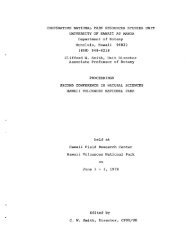american samoa - University of Hawaii at Manoa
american samoa - University of Hawaii at Manoa
american samoa - University of Hawaii at Manoa
You also want an ePaper? Increase the reach of your titles
YUMPU automatically turns print PDFs into web optimized ePapers that Google loves.
Scvcral other trees are characteristic <strong>of</strong> Alava ridge,<br />
but arc more heliophytic (sun-loving) species th<strong>at</strong> do<br />
not do well in the shade <strong>of</strong> undisturbed montane<br />
forest. 'The three most significant <strong>of</strong> these are<br />
Me/ro.videros collina, Spiraeanlhemum samoense, and<br />
Glochrdion cuspid<strong>at</strong>um, Metrosideros, which is<br />
probably the same species th<strong>at</strong> comprises most <strong>of</strong> the<br />
n<strong>at</strong>ive forests in Hawai'i, domin<strong>at</strong>es the scrubby<br />
veget<strong>at</strong>ion found on the upper part <strong>of</strong> the steep slopes<br />
<strong>of</strong> Alava Ridge, especially around the TV transmitter.<br />
Spirueanthemum is also common there, and was found<br />
to be the dominant species in one type <strong>of</strong> cloud forest<br />
<strong>at</strong> I600 m elev<strong>at</strong>ion on Savai'i (Whistler 1978).<br />
Glochidion cuspid<strong>at</strong>um is more <strong>of</strong> a secondary forest<br />
tree closely rel<strong>at</strong>ed to Glochidion ram@orum, a tree<br />
th<strong>at</strong> typically occurs in disturbed forests <strong>of</strong> the<br />
lowlands. Also common on these slopes are Neo-<br />
nauclea forsteri (afa), which is a secondary forest<br />
canopy species, and Syzygium samoense.<br />
Some <strong>of</strong> the ridge top from the TV transmitter to<br />
the beginning point <strong>of</strong> the old trail down to V<strong>at</strong>ia is<br />
currently domin<strong>at</strong>ed by thickets <strong>of</strong> Hibiscus tiliaceus<br />
(fau). This tree is common in many types <strong>of</strong> habit<strong>at</strong>s,<br />
especially disturbed ones, and its presence is probably<br />
the result <strong>of</strong> previous cultiv<strong>at</strong>ion along the stretch <strong>of</strong><br />
ridge. Most <strong>of</strong> the rest <strong>of</strong> the ridge in this area is open<br />
montane forest consisting <strong>of</strong> sc<strong>at</strong>tered trees growing<br />
out <strong>of</strong> a dense ground cover.<br />
The distinction between the lower limit <strong>of</strong> the<br />
montane forest and the upper limit <strong>of</strong> lowland forest is<br />
not very clear, because there is a zone <strong>of</strong> variable<br />
width where the characteristic species <strong>of</strong> the two<br />
communities share dominance. In plot 11 (Appendix<br />
B) <strong>at</strong> 350 m elev<strong>at</strong>ion, for example, the five dominant<br />
trees were Calophyllum neo-ebudicum, Syzygium<br />
inophylloides, and Buchanania merrillii, which are<br />
lowland forest species, and Syzygium samoense and<br />
I-lernandia moerenhoutiana, which are montane forest<br />
species.<br />
In undisturbed montane forest, the ground cover is<br />
<strong>of</strong>ten dense, and is comprised <strong>of</strong> shade tolerant ferns.<br />
The most characteristic and abundant species is<br />
probably Lomagramma cordipinna (Fig. 24); other<br />
common species include Asplenium nidus, Asplenium<br />
polj~odon, Trichomanes spp., and Microsorium<br />
.sy/vdicum.<br />
Other plants present in the forest floor <strong>of</strong> montane<br />
Sorest include Angiopteris evecta (king fern, nase),<br />
Murallia smithii, and Cy<strong>at</strong>hea vaupelii (olioli).<br />
Angiopteris and Mar<strong>at</strong>tia are very similar to each<br />
other-they have long thick fronds arising from a<br />
thick base. Cy<strong>at</strong>hea is a small tree fern. These<br />
ferns are present in both undisturbed and dist-<br />
urbed forest. Also common in these places are<br />
Zingiber zerumbet (wild ginger, 'avapui), Helico-<br />
nia laufao (laufao), and Cordyline fruticosa (ti).<br />
N<strong>at</strong>ive grasses such as Centosteca lappacea (sefa),<br />
Oplismenus compositus, and Cyrtococcum<br />
oxyphyllum are also found in montane forest, most<br />
<strong>of</strong>ten in clearings or along trails.<br />
In the disturbed montane forest on Alava ridge,<br />
the n<strong>at</strong>ive, shade tolerant ferns are outcompeted in<br />
the sunny conditions by introduced, weedy<br />
heliophytic species, the most common <strong>of</strong> which<br />
are Mikania micrantha (fue saina), Clidemia hirta,<br />
and Paspalum conjug<strong>at</strong>um (vao lima). Mikania is<br />
a vine th<strong>at</strong> grows over low veget<strong>at</strong>ion and even up<br />
in the lower branches <strong>of</strong> trees. Clidemia is a<br />
noxious shrub th<strong>at</strong> is uncommon in lowland forest,<br />
but very common in the summit scrub community<br />
<strong>of</strong> Ta'u (although it apparently did not reach th<strong>at</strong><br />
island until after 1976). Also common here are the<br />
two Freycinetia species, which <strong>of</strong>ten form dense<br />
tangles th<strong>at</strong> are traversed only with difficulty.<br />
The amount and variety <strong>of</strong> epiphytes is another<br />
characteristic th<strong>at</strong> serves to distinguish montane<br />
forest from lowland forest. The difference is not<br />
only in the amount or biomass <strong>of</strong> epiphytes, but<br />
also in the number <strong>of</strong> species present. The<br />
montane forest is the most floristically diverse on<br />
Tutuila, not only for epiphytes, but also for trees<br />
and ground cover species. Because <strong>of</strong> the cooler,<br />
conditions in the montane forest, there is a pro-<br />
fusion <strong>of</strong> epiphytes th<strong>at</strong> are mostly absent from<br />
lowland forest. By far the most important epi-<br />
phytes are ferns and orchids. Only one epiphytic<br />
vascular plant species reported here was neither a<br />
fern (or fern ally) nor an orchid-Procris pedun-<br />
cul<strong>at</strong>a, a member <strong>of</strong> the nettle family. It was not<br />
very common, however.<br />
Many <strong>of</strong> the trees on the less disturbed parts <strong>of</strong><br />
Alava Ridge are covered with epiphytes. The<br />
most characteristic fern is probably Trichomanes<br />
humile, a filmy fern th<strong>at</strong> cannot exist in drier<br />
forests. Also common are Hymenophyllum<br />
imbric<strong>at</strong>um (another filmy fern), Hymenophyllum
















